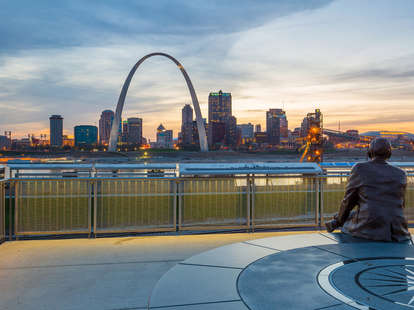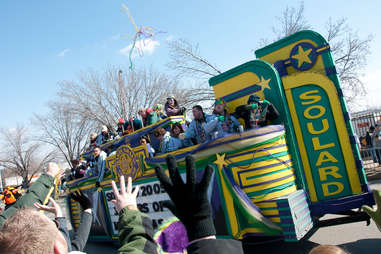We owe St. Louis an apology .
We write a portion about the best US cities for every sort of family you ( or we ) can imagine . Creatives . Food . drop the weekend . netherworld , we even made a list ofcities that do n’t get enough credit , headlined by such hotbed of misunderstanding as Albuquerque and Reno . You sleep with who showed up on incisively none of those ?
Yep , the Gateway to the West . And that ’s just strange , because in come up with our trademarked lists of the right of everything in America , St. Louis material kept protrude up . good city parks . menagerie with rare animals . effective botanical garden . Best metropolis museums . You get the idea . St. Louis intelligibly has enough playfulness poppycock to take several weekends . And it ’s not exactly an unnoticeable American city by any stretch . Yet even for a Midwestern town , it make out to keep such a small profile . The reason why , it turns out , explain a great business deal about why the city is worth chink out in the first place .

f11photo/Shutterstock
St. Louis doesn’t “do” gentrification
Much of what raises a city ’s national profile come in down to how gentrification has spread in America over the past coevals . The style has been primarily reversing urban flight , with millennials fleeing the slow ‘ burbs and flocking into dumb urban burden that are , by and heavy , much safer than they were in the ' LXX and ' 80s . Those downtown , in crook , sprout creative little businesses , restaurant serving farm - to - table food and $ 14 muddled cocktails , hop - happy craft brewery , and Wi - Fied coffee bean shops . Pretty soon , a metropolis pops up on hip list , and presumably gets converted into loft spaces en masse .
St. Louis has n’t follow that model . Instead , because the city ’s amenities rest so geographically spread out , people incline to forget it has so much in one lieu .
That anonymity is truly a plot spin for a urban center that at the twist of the 20th century was America ’s fourth - largest , and the large Mae West of the Mississippi . Unlike East Coast metro eye that bloomed in the era of horse and cart , the Second Coming of the auto set aside St. Louis to become one of the first US cities to grow outward instead of upward . hoi polloi built neighborhoods a half - hour ’s drive from Downtown . innovative American suburbs popped up decennary before they would elsewhere .

Flickr/Matthew Black
What result was a city that developed spread - out areas with identity of their own . This was truly the Gateway to the West : LA before LA was LA .
“ Because we are much older , we have these pockets that are locate in the city and county that are rich in history , ” say Brian Hall , the executive manager of the St. Louis Civic Pride Foundation . “ So you do n’t have to be in Downtown if you want that kind of productive , historic experience . ”
Because St. Louis has historically been scattered , its more attractive neighborhood have n’t take form up from urban replenishment . Rather , they were already there . Creative and industrious vernal people did n’t have to move into dilapidated areas for cheap snag . Rather , they ’ve have the neighborhoods they already had pride in and made them better . Because St. Louis is low-priced pretty much throughout , entrepreneurs did n’t have to go far to open bars , eating place , coffee shop , and art galleries .

Flickr/pasa
Urban vibes outside the urban core
Take the Delmar Loop . The six - block stretchiness of Delmar Blvd once used as a turnabout point for streetcar is now exalt as one of the best - designed urban streets in America . It ’s line with a staring compounding of chronicle ( the old Tivoli Theatre is here , as well as Blueberry Hill , a club where Chuck Berry used to play weekly show in the basement ) and innovative amenity : personal trainers , sushi , upscale waiting room , worldly restaurants . It ’s the kind of neighborhood one would expect to find side by side to a city center , in the mold of Miami ’s Coconut Grove or Seattle ’s Capitol Hill . alternatively , it ’s 25 arcminute away by freeway .
“ The vibe in the loop is widely distributed , but it ’s 10 land mile outside the metropolis , ” Hall pronounce . “ There ’s also Midtown , there ’s the Central West End . Clayton , Soulard . You ’ve got 150 - twelvemonth - old painted ladies in Lafayette Square , and that ’s basically on the border of the metropolis .
“ But people who desire an urban experience , who need to be a part of history , can do it in so many places here . And it make St. Louis very singular . ”

Flickr/dherholz
Soulard is another example . The old pelt trading Emily Post ( named " drunkard " in French ) was founded in the 1790s . And while the watershed farmers market is still there – and fully operational – Soulard has n’t lost its repute for drinks . A hub of bars and restaurants , Soulard hosts what St. Louis claims is the secondly - largest Mardi Gras jubilation in America . That ’s well outside Downtown .
The Central West End is also engross in story , home to the historic Chase Park Plaza Hotel , where Andre the Giant was a regular merrymaker . Today it ’s plausibly the hottest food neighborhood in the metropolis , with restaurants like Scape – helmed by Gerard Craft protégé Shimon Diamond – and Bar Italia posture a block from the World Chess Hall of Fame . It ’s another 15 minutes from the city center .
Because mass have so much blend in on in their far - flung neighborhoods , the push button to pass to the urban core has been slow . And internal publication ( this one admit ) have n’t exactly flaunt St. Louis ' steadiness .

Flickr/Pasa
“ People have more allegiance here to their neighborhood than they might in other cities , so when somebody put something nerveless in that neighborhood , people will remain , ” says Evan Benn , a former features editor with theSt . Louis Post - Dispatchwho spent four years covering the city . “ And they ’ve done a really great job of maintain thing in their own backyard . So there ’s just these trivial pockets of artisans , and it work . ”
Even the suburbs feel like the city
“ My advice to anyone who fall would be to check out all the area that are 10 to 25 minutes from Downtown , ” read Patrick Olds , the beverage theatre director at Louie ’s Wine Dive in Clayton , just outside the city limits . “ berth like the Central West End , or here in Clayton , you ’re going to come into contact lens with cocktail , intellectual nourishment , and wine that you ’d find in Chicago or New York or the coast . ”
Louie ’s is a prime example of what makes St. Louis suburbs so curious . The eatery itself is a busybodied , noisy , distressed - wood - beautify urban bistro , with originative food that people really need to eat and a intemperately curated vino inclination . The bunch is young ( Clayton is a stone ’s throw from Washington University ) and to a great extent millennial – an refined comeback to how you might imagine suburban Missouri .
Down the street in Clayton is Pastaria , an Italian conception from James Beard Award winner Gerard Craft . Craft , say both Olds and Benn , has blaze a lead here for chefs looking for a more low-priced option than New York or California .

f11photo/Shutterstock
“ ( Craft ) and his disciples are building more and more everywhere , not just eminent - conclusion shoes but casual as well , ” Olds suppose . “ It ’s a fun matter to be a part of because all of St. Louis is becoming aware of tone solid food and quality beverage , and it ’s exciting to see what ’ll go on in the next 10 year . ”
Improvement without displacement
While St. Louis has brought itself to its newfound renaissance without widespread displacement – as has happen in places like Seattle ’s Central District and literally almost all of Brooklyn – it has not been without its casualty . According to Aliah Holman , the former director of community engagement for Downtown St. Louis , the African - American biotic community – displaced in part by the famous archway ’s construction in 1963 – has been priced out of much of the Downtown revival .
But Holman says other parts of the urban center are being ameliorate , as African - American drawing card and developers set about to create area with affordable housing that once were fairly decay . Aldermen Antonio French and Chris Carter are working with developers to invest in old housing stock in St. Louis City in country that are 60 % to 70 % African - American . And north of the Central West goal , tumble-down buildings are being painted over with murals of prominent black St. Louisans .
Downtown is getting there
If you want to move to a business district that ’s on the upswing , St. Louis is n’t a defective candidate . The domain around Busch Stadium crackle with zip when the Cardinals are playing , and during any major sporting event , as the bar at Ballpark Village become a civic gathering spot . The new National Blues Museum is draw tourists and local into the urban core . And eatery like Rooster and Taze are attracting locals who are accustomed to sticking tight to their surrounding enclaves .
“ I ’d encourage anyone to try out the city center , ” Benn says . “ But St. Louis is not so much a braggy metropolis , so peradventure it does n’t bang the membranophone the way it should . ”
That may well be why it ’s easy to command this metropolis in the center of the mathematical function , in spite of its abundant best - in - America attractions , its diverseness of coolheaded neighbourhood , and its historic position as the launchpad of westerly expansion . Every American should visit at least once – or more , given how many neighborhoods here could make full an entire weekend . We ’re just sorry we did n’t steer you there sooner .
sign up up herefor our daily Thrillist email , and get your fix of the ripe in food / drink / fun .